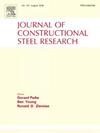Seismic analysis of large-span CFST arch bridge considering the stress accumulation effect
IF 4
2区 工程技术
Q1 CONSTRUCTION & BUILDING TECHNOLOGY
引用次数: 0
Abstract
To investigate the effect of stress accumulation during construction process on the seismic response of large-span CFST arch bridges, the typical construction process and the resulting stress accumulation history in the CFST arch sections are first explained, and a static-dynamic sequence analysis method is then proposed considering the nonlinear properties such as material, geometry, and boundary conditions. In this method, the stress accumulation in the essential processes of empty steel tube erection and concrete placement through multiple working faces is modelled. Moreover, the effect of creep and shrinkage, which is activated at different concrete ages, can also be incorporated in this method. For comparison, two models were established with and without considering the effect of stress accumulation respectively. A comprehensive discussion is then conducted on the impact of stress accumulation on the seismic response of an illustrated arch bridge, focusing on three key aspects: the differences in peak response, the extent of response differences under different earthquake intensities, and the variation in the position of peak responses. Finally, three models are further developed to examine the impact mechanism of each of three core factors: steel tube erection, infilling concrete placement, and concrete shrinkage and creep. The research demonstrates that the construction process of large-span CFST arch bridges significantly influences the seismic analysis results. Neglecting the three core influencing factors leads to discrepancies in response values, shifts in peak response positions, and potential misjudgments of the structure's elastic-plastic behavior. This study provides a rational seismic analysis method for CFST arch bridges.
求助全文
约1分钟内获得全文
求助全文
来源期刊

Journal of Constructional Steel Research
工程技术-工程:土木
CiteScore
7.90
自引率
19.50%
发文量
550
审稿时长
46 days
期刊介绍:
The Journal of Constructional Steel Research provides an international forum for the presentation and discussion of the latest developments in structural steel research and their applications. It is aimed not only at researchers but also at those likely to be most affected by research results, i.e. designers and fabricators. Original papers of a high standard dealing with all aspects of steel research including theoretical and experimental research on elements, assemblages, connection and material properties are considered for publication.
 求助内容:
求助内容: 应助结果提醒方式:
应助结果提醒方式:


